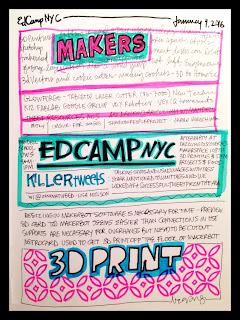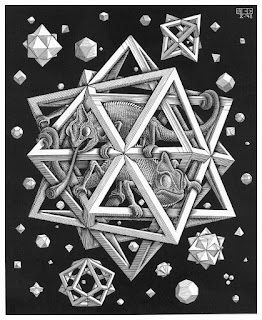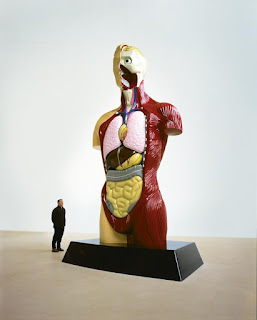
Here are 4 diverse ways to incorporate fine art into any curriculum:

Making words more visual has a profound effect on learning and remembering the material.

Visual students have a tendency to draw out notes in any class and sometimes get admonished for their doodles rather than being reinforced for visualizing the material. Encouraging students to create sketch-notes and modeling sketch-noting as an educator can be a very effective and simple way to incorporate arts into any curriculum with great positive outcomes.

Drawing out you notes helps separate the important takeaways from the page making it easier to see the most important learning and allowing educators to understand how the material is being processed rather than just copied.

The sketch-notes above are some of my examples but here are a few links to other examples and demonstrations available on the web:

Using paintings, drawings, illustrations, photographs, sculptures, and architecture to underscore material is a great way to incorporate the arts into any curriculum. Math teachers around the world have long been using artists like MC Escher in class and science and social studies teachers can easily visualize material with Davinci's notebooks.

Art history is a great tool but the issue is often finding the right art and artists to use in class so I suggest asking the art teachers in your school or local museums.
Here are a few of my favorite examples of art history references that can be used as examples for the core subjects:

Science: Damien Hirst, Leonardo DaVinci, Daniel Goldstein, Zahner Company

Math: Tony Robbin, MC Escher, Piet Mondrian, Albrecht Dürer

English/Language Arts: Lewis Carroll, Billy Collins, United States of Poetry, Aubrey Beardsley

Social Studies: Ai Weiwei, Gilbert Stuart, Banksy, Oliver Jeffers

Asking students to illustrate concepts and ideas can lead to some powerful learning and connections. I made an artistic leap in high school when my English teacher offered an option to draw a piece based on the book that we were reading rather than write an essay. Here are a few great examples of illustrations for different subjects:
This student drawing references World War II and incorporates what was learned in an original way.
A student pen and ink illustration of a massacre in China.
This mini-comic book is based on graphic novels that students studied in English class.
They are created with just one piece of paper that is folded into 8 pages that becomes a piece of micro-fiction.

Using inexpensive and recycled materials like cardboard, tape, and glue students can create 3D visualizations of what is being learned in any discipline:
It can range from a short day long activity to a longer, collaborative project that results in a cardboard sculpture to decorate the classroom and reinforce what was learned:
For inspiration look at an artist like Wayne White who we learned in my studio art class and who inspired us to create 3D works of famous artists in class:
The advent of 3D printing also allows students to create 3D designs easily that are virtual using apps like Morphi and Tinkercad among others.

Here are 4 diverse ways to incorporate media art into any curriculum:

I love using Vine to introduce my students to how we can use video in class. Here are a few examples of demonstrations and visual illustrations of lessons:
Once you master the basics of creating and sharing these videos you can pair Vine with other iphone apps such as Replay and Hyperlapse allowing time-lapse and text:

Animation is an incredible resource for education. There are various techniques that range from simple demonstrations using time-lapse to animated sketch-notes to complete digital animations that aid students in understanding curriculum in school in a different way. The example below is a terrific TED talk by author Dan Pink that was animated as sketch-notes by the RSA and it really communicates his ideas is a clear way:
Here'a an example of a collaborative animation that was created in class with each student drawing one aspect of author Stephen Fry's essay:
If educators don't have time to create that kind of animation they can always pair a short animation with Vine for a demonstration or showcase of student work. This can be done in just a few minutes, here are a few of my examples:
It's also possible to work with an outside educational entity like my friends at Art Heroes who created this amazing visual animation showing the basics of design:

There's no question that social media is fast becoming a major part of our future so it really makes sense to utilize it as a way to communicate ideas, teach, and incorporate the arts. If educators don't have any experience incorporating the arts into the teaching why not use social media like SKYPE in the classroom, Twitter, and Google to connect and collaborate with an art class for a shared, interdisciplinary lesson.
I've had great success collaborating and incorporating visuals into lessons with other classes and schools from around the world. Here's an example from a Japan Society partnership with a class from Japan paired with my class in NY:
This kind of activity also adds another layer of cultural understanding but social media also allows opportunities that wouldn't be possible otherwise such as Mystery SKYPE's and Google Hangouts with professionals in the field. I had the opportunity to have my students interview actor and musician Nick Cannon in school a few years ago and the conversation ranged from bullying to the arts.

There are other ways to use video to incorporate the arts into different disciplines like the example below of a video poem. Visualizing writing adds another dimension to the words and allows the writing to be shared and enjoyed in a new way.
Student created public service announcements such as this example created with our school improvement team are another great example of how educators can use video to communicate to the school and community.
Video is also great as a tool for student reflection that can be shared with future classes. I edited together some of the short student reflections with examples to create the video below that shows what we do in class and gives future students, colleagues, parents, and the community a better idea of what is happening in my classroom.
There are also great free educational resources to use such as PBS Learning Media which offers videos, lesson plans, and assessments that are catered to various disciplines:
Thanks, if you have any questions or comments please contact me:










No comments:
Post a Comment